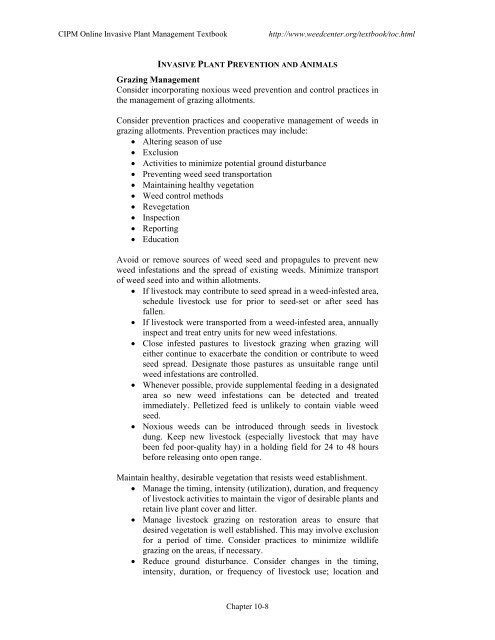Chapter 10 - Center for Invasive Plant Management
Chapter 10 - Center for Invasive Plant Management
Chapter 10 - Center for Invasive Plant Management
Create successful ePaper yourself
Turn your PDF publications into a flip-book with our unique Google optimized e-Paper software.
CIPM Online <strong>Invasive</strong> <strong>Plant</strong> <strong>Management</strong> Textbookhttp://www.weedcenter.org/textbook/toc.htmlINVASIVE PLANT PREVENTION AND ANIMALSGrazing <strong>Management</strong>Consider incorporating noxious weed prevention and control practices inthe management of grazing allotments.Consider prevention practices and cooperative management of weeds ingrazing allotments. Prevention practices may include:• Altering season of use• Exclusion• Activities to minimize potential ground disturbance• Preventing weed seed transportation• Maintaining healthy vegetation• Weed control methods• Revegetation• Inspection• Reporting• EducationAvoid or remove sources of weed seed and propagules to prevent newweed infestations and the spread of existing weeds. Minimize transportof weed seed into and within allotments.• If livestock may contribute to seed spread in a weed-infested area,schedule livestock use <strong>for</strong> prior to seed-set or after seed hasfallen.• If livestock were transported from a weed-infested area, annuallyinspect and treat entry units <strong>for</strong> new weed infestations.• Close infested pastures to livestock grazing when grazing willeither continue to exacerbate the condition or contribute to weedseed spread. Designate those pastures as unsuitable range untilweed infestations are controlled.• Whenever possible, provide supplemental feeding in a designatedarea so new weed infestations can be detected and treatedimmediately. Pelletized feed is unlikely to contain viable weedseed.• Noxious weeds can be introduced through seeds in livestockdung. Keep new livestock (especially livestock that may havebeen fed poor-quality hay) in a holding field <strong>for</strong> 24 to 48 hoursbe<strong>for</strong>e releasing onto open range.Maintain healthy, desirable vegetation that resists weed establishment.• Manage the timing, intensity (utilization), duration, and frequencyof livestock activities to maintain the vigor of desirable plants andretain live plant cover and litter.• Manage livestock grazing on restoration areas to ensure thatdesired vegetation is well established. This may involve exclusion<strong>for</strong> a period of time. Consider practices to minimize wildlifegrazing on the areas, if necessary.• Reduce ground disturbance. Consider changes in the timing,intensity, duration, or frequency of livestock use; location and<strong>Chapter</strong> <strong>10</strong>-8
















